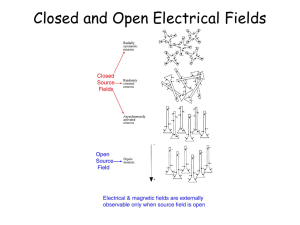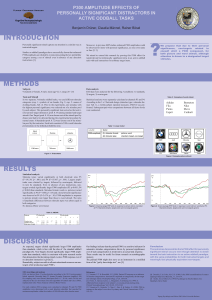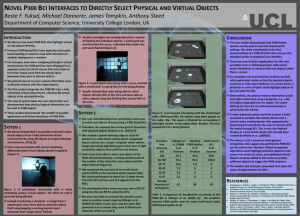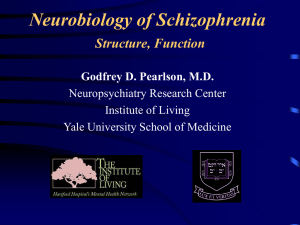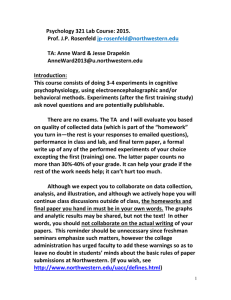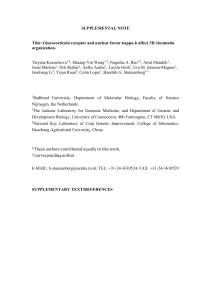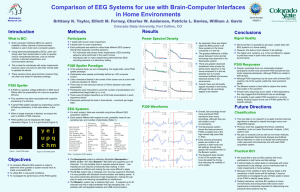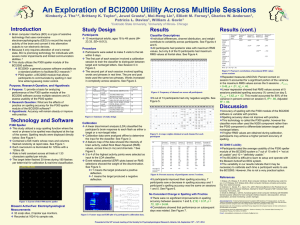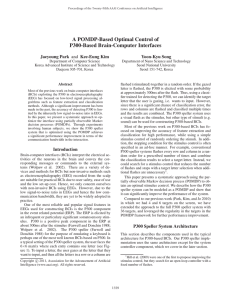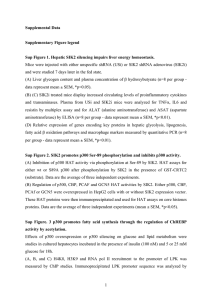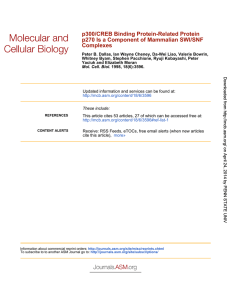P300 in Detection of Deception
advertisement
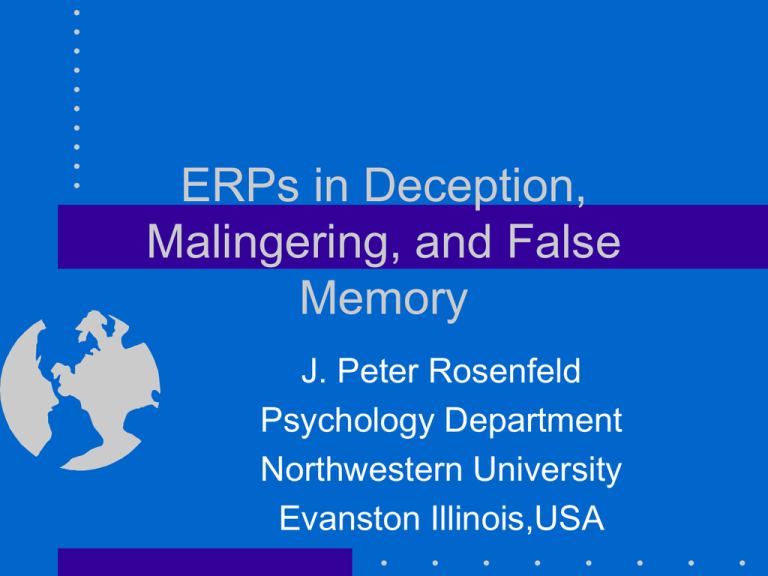
ERPs in Deception, Malingering, and False Memory J. Peter Rosenfeld Psychology Department Northwestern University Evanston Illinois,USA Principal Collaborators to 2008: • • • • • Joel Ellwanger Tuti Reinhart Miller Archana Rao Matt Soskins Greg Bosh Ming Lui • Many of the original ideas here were theirs. A simple neural code Event-related potentials P300 Attributes: • An Endogenous, Event-Related Potential (ERP) • Positive polarity (down in Illinois). • Latency range: 300-1000 msec – varies with stimulus complexity/evaluation time • Typical Scalp Amplitude(Amp) Map – Pz > Cz > Fz • Amp = f(stim. probability, meaning) P300 at 3 scalp sites We are always wanting to compare waves… • ..that is, group or condition • averages! EVENT RELATED POTENTIAL AVERAGING….. …..from 4 sites on the scalp: HERE IS WHAT SPONTANEOUS EEG LOOKS LIKE…… HERE IS A SINGLE SWEEP … HERE ARE 3 TRIALS…. the class to the movie…called, “ERP Averaging” REMINDER FOR PROF TO TAKE Since averages are so much cleaner than single sweeps, …and show the true stimulus-evoked event that is time-locked to the eliciting event, and are more noise free, ….it obviously makes sense to compare averages rather than single sweeps, that is, to do analysis, like t-tests on averages. People did that in comparing group ERPs or grand averages. For example, • The schizophrenic group average versus the normal average • or the well-trained group average P300 vs. that of the untrained group. • Remember, in a group, each subject has an average ERP. • ….but within a single subject, there are only single sweeps to compare In Bootstrapping… • …..the original set of single sweeps is repeatedly randomly sampled –but with replacement— …yielding multiple averages in a single subject. • Let’s say there are 6 repetitions of sampling of 18 single sweeps: EACH SET OF 18 SINGLE SWEEPS IS AVERAGED YIELDING 6 AVERAGES… ….that look like real average of original set but with variations P300 amplitude as recognition index • Autobiographical items (previous slide) • Guilty Knowledge test items (Rosenfeld et al., 1988) • Antisocial/illegal acts in employee screening (Rosenfeld et al., 1991). • Tests of malingered cognitive deficits with oddball paradigm. Do folks recognize personal info? Start with normal models…. 3-stimulus protocol • 1probe • 2 irrelevant • 3 target Normals: autobiog. oddball CHI patients: autobiog. oddball Individual detection rates for various stimuli (normal simulators). E-Name forgetters(oddball is dark line) Screening example Autobiographical paradigm has limitations in detecting malingerers • Most malingerers are not so unsophisticated as to verbally state that they don’t recall, say, their birthdate, when in fact they may have just filled out a card in which they provided that information. • Continuation… • The behavioral “MDMT” was developed as an entrapment test to catch these people. It’s a simple matching-tosample test: A sample 3-digit number is presented followed either by a match or mismatch. Simple MDMT paradigm: • There is a 5-15 second interval between sample and probe. This is an easy task, yielding 100% performance even in patients with moderate head injury-unless, oddly enough, they happen to be in litigation ! • Where does one set the threshold for diagnosis of malingering? 90%? (Some non-litigating malingerers score well below 90%, as we’ll see.) Behavioral MDMT not reliable: Some non-litigating pts. fail P300-Souped-up MDMT: simple version • “Simple” means only one probe stimulus per sample. • P300 is recorded as soon as the probe -match or mismatch-- is presented. • Match probability is kept low. • RESULTS------------> Match-To-Sample example Computer-plotted data: What would 75%-HITTING plaintiff’s lawyer say? • “Sure, my client scores 75% correct and his P300 to matches is bigger than to mismatches. But that’s because he mostly DOES make the correct discrimination--but 75% is still less than normal. Therefore, give us the money (me, one-third).” • Continuation… • We did 2 experiments: 1) If a malingerer aims to score 75% correct, whither P300? 2) What happens to P300 with a really tough discrimination? Manipulated 75% “hit” rate produces a larger P300…. 100% 100% Experiment 2: Difficult tasks: 7 and 9 digit numbers, match to sample. P300 wiped out in difficult task, at 75%, even at accuracy> 90% Another View of same effect: Simple P3-MDMT summary: • If one fakes 75% hits, one’s P300 gets bigger(or doesn’t change). • If one has genuine difficulty--honest 75%--then P300 is totally removed. • These findings should allow discrimination of normals, malingerers, real deficit(pts). • BUT…diagnostic hit rate only 70% !! Scalp Distribution • For P300, Pz > Cz > Fz, usually, but… • There are many ways that this can be so: SITE AMP Fz Cz Pz Cz Fz Pz lie SITES truth AMP Fz Cz Pz Match-to-Sample Test: advanced version • • • • • • • 386 sample 212 457 386 (*) 789 325 123 Stimulus-Response Types • Match(R) probe – “Match” (RR--honest/correct) – “Mismatch” (RW--dishonest/error) • Mismatch(W) probe – “Mismatch” (WW--honest/correct) – “Match” (WR--dishonest/error) ERPs in Liar Group to R and W Deception swamps out R/W effect “Profiles” of Deception Truth vs Lie Groups Deception overcomes paradigm effects Specificity (“Pinnochio”) • Simple Truth vs. Lie Groups differ in task demands. • This is not relevant for practical field detection. • It is relevant for claims pertaining to a specific lie response. • How do you make a “perfect” control group? An imperfect(but not bad) control Two groups run in two trial blocks of autobiog. oddball: [1. Phone #, 2. Bday] • Lie Group – Block 1 : Respond truthfully, repeat forwards. – Block 2: Lie 50% of time, repeat forwards. • Control Group – Block 1: Respond truthfully, repeat forwards. – Block 2: Respond truthfully, repeat backwards(50%). Only lying liars stick out. Same result with simple truth control Lie Response<>Truth Response; Psychopathy is irrelevant(swamped). Problems with these simple oddball methods… • (1) All the data I have shown --with respect to scalp distribution-- were based on group analysis, whereas in deception detection, individual diagnosis is the key and we never did better than 73% accuracy, even with 32 electrodes! • (2) Countermeasures…more later… False(honestly believed)memories: • Deese/Roediger paradigm – Presented words at study: sleep, bed, dream,blanket,pajamas,dark…. – Not presented word: night. • Test words: – night-- a critical LURE--> possible responses: “Old” or “New” – bed-- an actual memory word “Old” – table-- a completely new word “New” Profiles depend on belief: Replication data: almost ditto P300 Latency is the unconscious recognizer Replication data: ditto ! What’s next? • What does Malingered “false” memory look like? • Again, what happens as sites are added? • ________________________________ • jp-rosenfeld@northwestern.edu
